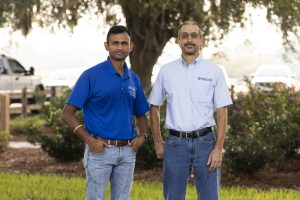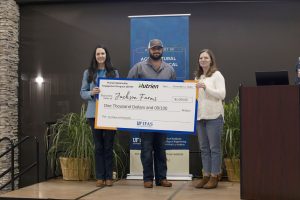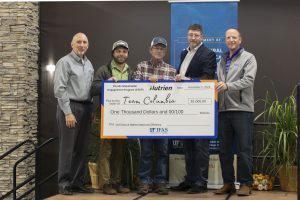Think of it like one of those farm simulator video games, except the crop is real.
A few small plots of land, ample seed and all the requirements to make it grow. This is the basis of the UF/FAS Extension Florida Stakeholder Engagement Program (STEP), which just concluded its second year growing corn at the UF/IFAS North Florida Research and Education Center, Suwannee Valley (NFREC-SV).
The competition, funded by the Florida Department of Agriculture and Consumer Services (FDACS) Office of Agricultural Water Policy, was devised to introduce best management practices and new technologies, while generating data on what makes for a successful harvest.

“For the last hundred years or so, traditional Extension programs like field days and workshops have taught growers how to improve production, which has certainly been effective,” said Vivek Sharma, assistant professor in the UF/IFAS department of agricultural and biological engineering, who modeled Florida’s STEP project after a similar program at the University of Nebraska-Lincoln, his alma mater. “But at the same time, there can sometimes be a barrier to taking that information back to the farm. Maybe it’s technical fluency, cost challenges or perceived risk from changing a farming practice.
“The STEP program tries to overcome those barriers by using an action-oriented learning approach that engages farmers in a friendly competition and allows them to control part of the research without incurring risk on their own farms.”
The 2023 competition brought together 14 teams. Some were growers from North Florida paired with their local Extension agent or consultants; there were family teams and even a group from FDACS. All told, Sharma said, the teams’ geographical extent represents about 20,000-25,000 acres of Florida farmland.
“The biggest learning component is not the installation or application of fertilizer or irrigation, it’s about making decisions,” Sharma said. “The field was open and accessible if anyone wanted to check in on their plots, but most of the participants also have their own fields to tend to. So, we collected soil samples, tissue samples, drone images, and all of that data was made available to them, too.”
Each competing team made choices that were then applied to their assigned research plots at NFREC-SV:
- Seed variety: Thirteen seed companies provided 14 hybrid corn seed options. Competitors could select from these or provide their own seed.
- Seeding rate: Teams chose how many seeds were planted per acre.
- Nitrogen management: Nitrogen was a focus because of groundwater concerns in the Suwannee Valley. Competitors could select between conventional or controlled-release fertilizers and choose the application rate and method.
- Irrigation management: Teams chose when and how much to irrigate and used technologies like soil moisture sensors and irrigation apps.
- Crop insurance: Teams made hypothetical crop insurance selections (insurance type and coverage level), which determined the premium cost and possible indemnity payments, on paper.
- Grain marketing: Each team chose when to sell corn and how many bushels for hypothetical forward contracts, which determined the team’s average corn price, on paper. Contract prices were based on real week-to-week prices quoted by local buyers.
“Different management practices, even with the same seed, can yield different results,” Sharma said at a Nov. 2 banquet at the NFREC-SV pavilion, where participants and stakeholders gathered to learn the results of the 2023 competition.
At the concluding event, Sharma and Kevin Athearn – UF/IFAS Extension regional specialized agent for rural agribusiness development, who helped guide the economic aspects of the competition – took turns sharing the teams’ anonymous selections and results before announcing the competition winners. First-, second- and third-place prizes were awarded in the categories of profitability and efficiency, with Team Florikan earning the most profitable award and Deas Farm taking home the top prize for highest input-use efficiency.
Aside from the learning opportunities available to the participants, Sharma highlighted the competition’s ability to bring the agricultural community together.
“Growers are not the only ones in agriculture; there are consultants, seed companies, fertilizer companies, technology companies and crop insurers, as well as supporters, like the water management districts,” he said, noting several of these groups donated time and/or products to the competition. “This program has brought them all together, and it’s been a successful collaboration. I hope to continue this for many years.”
Sharma has his sights set on not only expanding to other parts of the state but also into hallmark crops in those areas. The expansion is already set to begin next spring at the West Florida Research and Education Center in Jay, where competitors will grow cotton; and the Suwannee Valley competition next returns with peanuts. Future events could involve tomatoes in Southwest Florida, potatoes in the Northeast, or even a regional competition that could include neighboring states.
Photos from the Nov. 2, 2023, awards banquet at NFREC- SV. The first-place winner for highest input-use efficiency and third-place winner for profitability were not in attendance. (Credit: McKenzie Wynn, UF/IFAS)
 2
2




